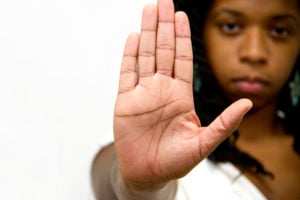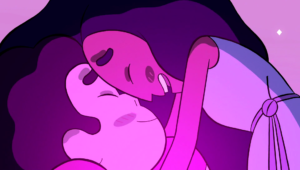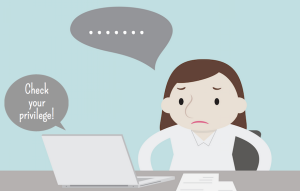I’ve got some important info for you if you’re a white guy who dates women. Especially if you’re in what I like to think of as one of the most exciting stages of dating – that moment right before you’ve met someone new, when there are all kinds of possibilities for connecting, getting butterflies, and having fun.
Okay, maybe “exciting” isn’t quite the word you’d use for this stage – since you haven’t yet found someone, there’s also a chance of rejection, incompatibility, and heartache.
So this may be a little nerve-wracking, but picture yourself in a setting where you just might meet someone special. A mixer with other people looking to mingle, an online dating site.
You spot someone you find attractive. She’s a woman of color, and she interests you, and that’s all you know about her so far.
Pause: White Supremacy and Patriarchy Are About to Make You Look Like a Jerk – And You Don’t Even Know It
Before you go any further, I’m here to help you out. The tips I’m about to share can steer you away from some shitty social norms that women of color have to deal with way too often.
This isn’t quite a wingwoman type situation, if that’s what you’re thinking – I don’t have the magical key to get you with any woman of color. We’re are all unique people, so it’s not as if one set of rules guarantees you a connection with one of us.
Unfortunately, a lot of the tools that you might hope to rely on when flirting will only hurt the women you’re pursuing – and leave you nursing the wounds of more rejection.
So here’s what you’re up against.
Society spreads some damaging messages about women of color when it comes to sex and relationships. These messages are reinforced everywhere, from music to television to pornography, so there’s a good chance that you’ve internalized some of them.
There are countless accounts from women of color on the negative dating interactions they’ve had – from the initial approach through sex and more.
We’re often fetishized, exotified, and demeaned – even by men who are supposedly interested in building a real connection with us.
Though my dating history includes of various genders and races, and my negative experiences haven’t been limited to white men, it’s clear that white supremacy and patriarchy inform these interactions in a particular way.
And a lot of times, it’s not a good look. I’ve heard all kinds of come-ons that turn me off, piss me off, and gross me out.
There were plenty of men who were outright insulting without apology – and if you’re one of those guys actually looking to demean women of color when you approach them, I’ll leave you with the pro-tip to leave us all the hell alone until you can work out those issues without hurting any of us.
But I’ve also had interactions with men who really were trying their best to appeal to me.
Some succeeded. Many, unfortunately, didn’t mean to insult me, but they followed common patterns of entitlement that left me without much hope that they would really value me as a person.
You can do better than that.
I’m sure you’ve got something special that can help you stand apart from the rest, and the strategies I’m sharing here could help you be among those who manage to approach women of color in a respectful way.
What You Could Have Once Oppressive Systems Stop Messing With Your Game
Instead of continuing a hurtful pattern, we could have a whole new way of relating to each other as white men and women of color.
You could have an awesome, respectful, and mutually beneficial experience once you learn respectful ways to connect with women of color.
Maybe you think I’m assuming you don’t know what you’re doing here – and stereotyping white guys and women of color alike by writing this guide.
After all, can showing respect to a woman of color really be all that different from respecting a white woman? Patriarchal lies can trick you into approaching white women in offensive ways too, so isn’t it enough to have just one general guide to non-creepy flirting?
Don’t worry, I’m rooting for happiness both for you and the woman you’re trying to flirt with.
I’m not demonizing you, and you probably don’t think of yourself as racist or sexist. So let’s be clear about where the potential racism and sexism in your actions is really coming from.
It’s not about your intentions. It’s about the systems in our society that encourage white men to relate to women of color in ways that have a racist or sexist impact – even if you don’t mean to do it.
So unless you’ve deliberately worked to unlearn what these oppressive systems have taught you, you’re probably working with some unconsciously hurtful ideas about how to approach a woman of color.
But if you’re looking to start a conversation, you can unlearn those unconscious biases to make it a respectful conversation – not one based on the inherently unequal dynamics society has set up between white men and women of color.
Any kind of relationship based on inequality is doomed – not only for rejection and heartache, but also for following harmful norms.
Let’s make sure both you and any woman of color you approach can avoid that pain – and have some fun.
Since there are no rules set in stone about what will work for you or the women you’re interested in, think of these more as guiding principles. There’s no guarantee that these tips will get you a date, and women of color don’t owe you anything, no matter how respectful you are.
But these strategies are a good starting place for figuring out what works for you and the woman you’re approaching.
What’s the worst that could happen? You could face some more rejection – but you’ll have tools for handling it in a healthy way.
And the best case scenario? The next time you get a chance to flirt with a woman of color who interests you, it could induce happy butterflies for you both.
So check out these warnings for what not to do – with ideas for what to do instead.
1. Don’t Focus Only On Her Race
Fetishizing, exotifying, dehumanizing – these are all common problems for women of color.
The problem isn’t that our race is acknowledged. It’s that we’re treated like our race is all we have to offer.
I’m proud to be Black, so if your opening line includes something like “African Queen” or “I want you to be my first Black girl,” you might think it’s a compliment.
But it actually feels pretty gross to know that you’re approaching me only because of my race. It feels like you’re not actually seeing me as a human being.
You probably hate to be “blamed” for the actions of your ancestors, but the truth is, white men throughout history have really fucked this one up for you.
Colonization, slavery, and imperialism have all had white men reducing women of color to how we’re different from white women, treating us like we were less desirable – but theirs to claim for “exotic” sexual adventures.
I’m not bothered by this only because I can’t shake off that disturbing history – it’s also because that history has set up our modern world with the same terrible ideas about women of color and sex.
For instance, have you ever watched pornography featuring Black women? Don’t be embarrassed – I have, too. And sadly, it’s difficult as hell to find porn that doesn’t market and depict us with demeaning characterizations like “Jungle Booties” or “Ebony Whores.”
It’s a lot rarer for porn to show us simply being sexual beings, without a fetishizing focus on our race.
So if you focus only on my race as if there’s nothing else interesting about me, you’ll fall right into that category of white men who demean me – even if you don’t mean to.
Instead: Find Something Other Than Her Race To Relate To
Okay, so all you know is that she’s a woman of color, but you’re not going to open with a line about her race.
So what will you open with?
Think about your goal here – are you relating to her or are you othering her?
After all, if you’re trying to establish a connection, you’re not going to do that by essentially saying, “Hey, I noticed you’re Black.”
Really? I didn’t realize it was so obvious. Yawn.
There are endless topics of conversation to choose from.
It’s not hard to find another one that could interest me, and it’d be (sadly) quite refreshing for a white guy to break the status quo by doing so.
Yes, I’m a proud Black woman, but there’s a lot more to me, too.
Try asking a woman what she likes to read – I’m a big book nerd, so that would work for me. Ask if she’s traveled anywhere interesting lately, or where she would go if she could. Ask about a patch on her backpack.
There are lots of ways to figure out how to relate to a woman.
If you’re on a dating site, for instance, your research is done for you – she didn’t fill out her profile just to have you skip reading it and send her a message. Read her interests, and you can get a good idea of how she’d like to be approached.
Personally, I’d think it was sweet if you took the time to learn my interests and then approached me based on what you learned. And it’s just a short hop from finding your approach cute to thinking you’re pretty cute as a person, too.
At the end of the day, I just want to know that you’re open to getting to know who I really am – not putting me in a box of who you think I am based on your perception of my race.
2. …But Don’t Act Like You Don’t ‘See’ Her Race
Now before you go avoiding any mention of race at all, let me clarify.
Focusing only on a woman of color’s race is a problem, but it’s okay to acknowledge that you are, in fact, aware that she’s a person of color.
In fact, it’s a hell of a lot better than saying things like “I don’t see color.”
Which might feel confusing. If you see an Asian woman and you want to avoid othering her, is telling her “I don’t see you as Asian” going to send the right message?
Probably not. Think of it this way: The basis of othering people is the underlying message that they’re not “normal.”
It’s cool to be treated like you’re special, but the idea that a woman is different simply because she’s Asian is not so great.
It essentially means that you’ve internalized what the mainstream media and other dominant institutions have told you – that white is the default identity, and anyone who’s not white is abnormal.
So if you’re telling a woman that you don’t “see” her race, you’re implying that you only find her attractive because you see her as the default race, white, and noticing that she’s not white would be a bad thing.
This goes hand in hand with lines like “You’re pretty for an Asian” or “You’re not like other Asian girls.”
Those are more insults than compliments. You can find ways to appreciate a woman of color without putting down everyone else who shares her ethnicity, as if she has to be as “un-ethnic” as possible to be appealing.
Don’t treat her race like it’s something to be ashamed of, something she’d have to “overcome” in order to get your attention.
Instead: Find Considerate Ways to Approach Her Race
Be thoughtful about how you acknowledge a woman’s race – which means not saying any of these things:
“I’ve heard Latinas are wild in bed.”
“I may look white, but I’m a Black guy in my pants, if you know what I mean.”
Even if you’ve reached a point in the conversation when you’re talking about race, it’s not okay to go about it with dehumanizing stereotypes.
Sharing a culture is one thing – but it doesn’t mean everyone who shares a culture is the same. We all have unique relationships to our heritage and communities, and with more respect, you can learn the specifics of what her culture means to her.
Say you meet a South Asian woman. A common pitfall is asking “Where you from?” and not accepting an answer like “Arizona.”
You may be earnestly trying to learn about her background, but you’re approaching her with assumptions that anyone who’s not white is from some “exotic” place – and it can make her feel like you think she doesn’t belong.
There are better ways to learn someone’s background and allow her to share about her identity on her terms.
One great way to do this is by following her lead. If you seem genuinely interested in getting to know her, there’s a good chance that her background will naturally come up in a way she’s comfortable with.
For example, if you asked me where I’d like to travel, I’d probably tell you I’d go to my father’s home country of Trinidad and Tobago.
Then you could ask any number of respectful questions about when he immigrated to the United States, and what my Trinidadian roots mean to me – without ever having to perpetuate xenophobic ideas about immigrants.
You can have similar approaches to conversations with other women of color. The next thing you know, you could be having one of those alluring, butterfly-inducing conversations – without ever having to ask, “But where are you really from?”
3. Don’t Assume She’s Interested in Talking to You
I realize this step seems obvious – why would you even want to talk to someone who wasn’t interested in talking to you?
Unfortunately, society encourages men to believe women are always sexually available to them. For example, romantic movies often show men interpreting a woman’s “no, thank you” as “try harder, and eventually you’ll get me.”
This entitlement can show up in ways that you don’t even notice, and it takes a particular form between white men and women of color.
If you implicitly believe in stereotypes about women of color (like many people do, even without realizing it), then the basics of reading when to engage and when to back off aren’t enough.
East Asian women, for instance, are stereotyped as submissive and demure. If an East Asian woman gives a kind smile as she turns down your request to talk, that doesn’t mean she’s actually willing to submit if you just insist on talking to her.
If you’ve come across the common stereotypes of “spicy” Latina women, you might think they’re constantly up for sexual attention. Don’t assume she must be interested just because she’s Latina.
Here’s an example of how stereotypes can complicate communicating my boundaries. Sometimes, I fall into the habit of being extra kind to try to avoid being stereotyped as an “angry Black woman.”
So I’m having an exhausting day, and then a guy approaches me – he seems respectful enough, but at that moment, I’m just not up for a conversation.
I might say “I don’t want to be bothered,” but give him a smile and also add, “but thanks, that’s nice of you to say hi.”
So many guys respond only to my appreciation, taking it as an invitation to keep pursuing me.
At that point, I realize I’m damned if I do, damned if I don’t. If I hadn’t been so friendly, maybe he wouldn’t have misinterpreted my signals – but he might also stereotype me as uptight just because I’m Black.
Women of color regularly deal with both sexual and racist harassment. When I’m responding to a greeting from a stranger, I have to be constantly aware that this casual interaction could turn disrespectful or even dangerous.
Don’t trap the woman you approach in this dilemma. Just read and respect her signs of whether or not she’s interested.
Instead: Respect Her Boundaries
Having respect for boundaries doesn’t necessarily mean you have to keep to yourself if there’s a woman of color you’re interested in talking to.
To build that vision of a world with new and respectful ways to relate to each other, we need to figure out how to be open to engaging with each other while still preserving our safety. Learning how to communicate and read each other’s boundaries is a big part of that.
Sure, you can give it a try and talk to me if you’re interested – but know the difference between entitlement and invitation.
Communicate that you’re inviting me into a conversation – but you respect my freedom to choose whether or not to take you up on your invitation.
Say you make a mistake and a woman of color feels offended by your approach. Or you’re totally respectful, but she doesn’t feel like talking to you at the moment. Or she flat-out tells you that she doesn’t date white guys.
Is this discrimination? Shouldn’t you be given some credit for trying?
It may feel unfair, but part of respecting a woman’s boundaries is learning how to not take it personally when she turns you down.
If she’s not interested, it’s not because she’s being “oversensitive.” It’s not even necessarily because she doesn’t find you attractive, or assumes you’re going to do something racist, or has any other impression of you being a “bad” person because you’re white.
The real problem isn’t just you. It’s the fact that women have to deal with being objectified all the time, and for women of color, that often includes a combination of racism and sexism.
For instance, society has objectified Black women to the point that we frequently have people – strangers included – trying to pet our hair like we’re exotic animals. Native women have their cultures appropriated and sexualized in the media – while they’re facing the highest rates of sexual violence.
Every woman of color has developed her own boundaries throughout her lifetime to protect herself from the impact of this constant weight.
Sometimes that includes turning down a polite stranger who’s trying to flirt – no matter how respectful he is.
Boundaries are not a form of discrimination against you. They’re an essential part of self-preservation for people from marginalized communities. She’s developed them for the sake of survival.
If you’re frustrated with this, direct your anger to the systems of white supremacy and patriarchy that put this burden on women of color. Don’t get angry at us for doing what we have to do to maintain our personal comfort and safety.
You can extend the invitation for conversation, and be open to wherever it goes from there. It’s okay if she says “no” – you’ll have plenty more opportunities to connect with other women, especially if you understand how to go about it respectfully.
4. Don’t Use the Same Lines as Everyone Else
Let’s talk about the fun part – once you get a chance to talk to this intriguing woman of color, what do you say to get her attention?
Dudes. There are a lot of the same lines going around among you, and hardly any of them are working.
The first thing you have to realize is just how often many women get approached by men with entitlement that’s anything from irritating to frightening.
Then consider that for women of color, disrespectful interactions can also include a dose of racism.
“I’m not usually attracted to your ethnicity, but I’m so into you.”
These men think they’re the first to say these things, but we’ve heard it all before. So you can understand why many of us have run out of patience for flirtations that are just like the others – especially when these so-called “compliments” really feel like backhanded insults.
I’m not saying this to scare you off and say you don’t have a chance to stand out from the hordes of men trying to get with us.
Knowing that all these guys are out there spitting the same game actually gives you a good strategy – all you have to do is get creative.
Because if you’re following the status quo, then you’re not showing that you have anything interesting to offer. Plus, that status quo is leading you down an oppressive path.
Instead: Be Original
For the love of all things holy or romantic or sexy or whatever floats your boat in this scenario – do something to stand out from the crowd.
You might think a woman’s “not giving you a chance” if she doesn’t stick around to find out if you’re going to be original. But then, you’d be surprised at just how predictable the guys who approach us can be.
Take, for example, the white men who say something along the lines of, “So, how do you feel about white guys?”
Let me guess how this will turn out.
He’s probably assuming I’ve never been with a white guy, and he’s promising that the experience will be something special. He’s also patting himself on the back for being “open enough” to be attracted to a Black woman, and I’d bet money that at some point, he’s going to treat me like some exotic token to add to his collection of “ethnic girls.”
He’s already demonstrated that he doesn’t see anything in me beyond my race, and he’s even categorizing himself as no different from a general idea of what “white guys” are like. To me, that communicates that he’s not promising any kind of experience that I haven’t been offered many times before.
There’s a difference between saying you’re something special (and being just like everyone else in the process), and showing that you’re going to be more creative and respectful than those other guys.
I know for a fact that I can’t fit you into a narrow box of “just another white guy.” You’re a unique human being, so show the woman you’re pursuing how you stand out.
For her, it’s about not just having fun, but also showing that you’re not following that whole oppressive status quo that the other white guys are. Which, to be honest, is a huge part of how many women of color form our first impressions about white guys who approach us.
Are you flirting with her because you find her “exotic” or because you truly appreciate her beauty? Will you treat her based on the way the rest of society tries to define her, or will you look beyond her appearance to connect with her as a person?
If you can find an original way to relate to the woman you’re interested in – and make it clear that you respect her choice on whether or not to engage with the conversation – then you’re already standing out from the crowd in the best possible way.
Here’s the Key
Okay, so maybe I lied when I said there is no magical key that works for everyone.
The key to everything including gauging if a woman of color is interested, knowing her boundaries, building a connection, and finding an original way to relate to her is all the same – listening.
It’s true for any relationship, right? If we’re not actually listening to each other, then we’re just playing guessing games about each other’s needs and desires. And eventually, someone’s going to get hurt.
I can’t guarantee that nobody will get hurt with these strategies, but I can assure you that listening to what a woman tells you – in both words and body language – will get you on the right track.
It’ll show that you’re interested in what matters to her. And that you see her as a unique person and not just an object.
You’ll also learn the specifics of how she’d like to be treated – which means you have my blessing to throw any of my suggestions out the window if you find out they don’t work for her.
This is all about honoring who she is as a person, rather than relying on any preconceived notions of who she is.
Following these principles, instead of the terrible ideas behind patriarchy and white supremacy, will allow you to have intimate and romantic relationships based on real connections and understanding.
All of us are developing our own ways of connecting with each other as we dismantle the oppressive systems between us. We’re all figuring it out as we go along.
So you’re not the only one who has some unpleasant lessons to unlearn. You’re committing to doing better, and that’s what’s going to make the difference.
I already think you’re pretty cool for sticking with me through this guide to learn how to be respectful. Carry these lessons with you, and you just might find someone else who sees this appeal in you, too.
[do_widget id=’text-101′]
Maisha Z. Johnson is the Digital Content Associate and Staff Writer of Everyday Feminism. You can find her writing at the intersections and shamelessly indulging in her obsession with pop culture around the web. Maisha’s past work includes Community United Against Violence (CUAV), the nation’s oldest LGBTQ anti-violence organization, and Fired Up!, a program of California Coalition for Women Prisoners. Through her own project, Inkblot Arts, Maisha taps into the creative arts and digital media to amplify the voices of those often silenced. Like her on Facebook or follow her on Twitter @mzjwords.
Search our 3000+ articles!
Read our articles about:
Our online racial justice training
Used by hundreds of universities, non-profits, and businesses.
Click to learn more





















